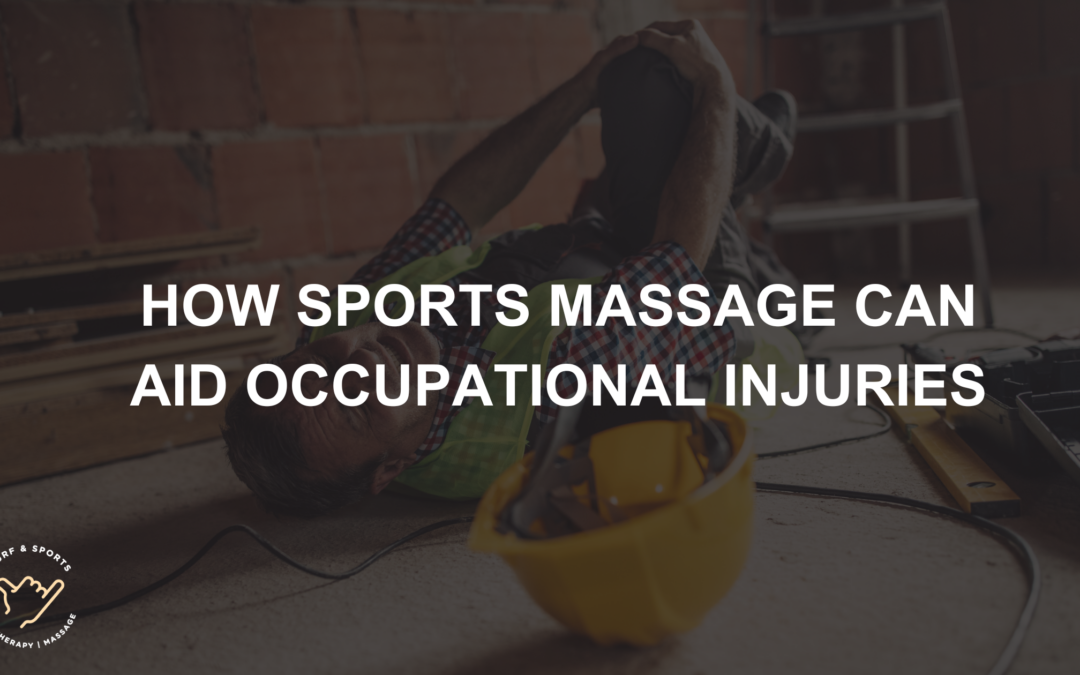If you’ve ever experienced an occupational injury or workplace accident, you know how it can impact your daily life. Whether it’s a work-related injury or a result of workplace hazards, finding effective injury management strategies is crucial for your well-being and occupational health. One approach that has shown promising results in aiding occupational injuries is sports massage.
Sports massage, typically associated with athletes and regular physical activity, offers various benefits that can help with injury prevention, recovery, and overall workplace safety. It involves specialized techniques tailored to different sports and sporting injuries, making it a versatile option for individuals with occupational injuries.
By targeting the soft tissues of the body, sports massage aims to relax muscles, improve circulation, and release stress. It can effectively reduce muscle pain and soreness, promote relaxation and stress relief, and enhance recovery time. Additionally, sports massage increases circulation and oxygenation, improving range of motion and reducing the risk of future injuries.
The Benefits of Sports Massage for Occupational Injuries
Sports massage offers numerous benefits for individuals with occupational injuries. One of the key advantages is its ability to reduce muscle pain and soreness. Through the process of increasing blood flow to the affected area, sports massage promotes the release of endorphins, which are natural painkillers. This not only provides relief but also aids in the healing process.
In addition, sports massage plays a crucial role in promoting relaxation and stress relief. High stress levels and anxiety are common among athletes and individuals with occupational injuries. Sports massage helps to alleviate these issues by inducing a state of relaxation, which can significantly improve overall well-being.
Moreover, sports massage is beneficial in terms of improving recovery time. By increasing circulation and oxygenation, it enables muscles to recover more rapidly. This enhanced recovery rate is especially vital in occupational injuries, where getting back to work quickly is essential.
Another advantage of sports massage is its impact on range of motion. By reducing muscle tightness and enhancing flexibility, sports massage improves an individual’s ability to move joints and muscles. This ensures a wider range of motion and ultimately aids in injury prevention.
“Sports massage reduces the risk of future injuries by addressing various factors such as muscle tension, flexibility, and circulation,” says Dr. Emily Adams, a renowned sports therapist. “By targeting these areas, sports massage helps individuals maintain optimal physical condition, thereby reducing the likelihood of further injuries.”
Therefore, incorporating sports massage into a comprehensive injury management plan is crucial for individuals with occupational injuries. Its wide range of benefits includes pain and soreness reduction, relaxation and stress relief, improved recovery time, enhanced range of motion, and injury prevention. By seeking the assistance of trained sports massage therapists, individuals can experience the advantages offered by this therapy and regain control of their occupational health.
How Sports Massage Works for Occupational Injuries
Sports massage is an effective therapy for addressing occupational injuries by employing targeted techniques and movements to alleviate pressure and strain on the muscles, joints, and soft tissues. There are several commonly used techniques in sports massage that contribute to its effectiveness in injury management.
Deep Tissue Massage
One such technique is deep tissue massage, which involves applying firm pressure and slow strokes to reach deeper layers of muscle and connective tissue. This technique is particularly beneficial for individuals with work-related injuries as it helps release tension and tightness in the affected muscles, promoting pain relief and improved mobility.
Trigger Point Therapy
Another technique commonly used in sports massage is trigger point therapy. This technique involves applying pressure to specific points on the body that are causing pain, tension, or discomfort. By targeting these trigger points, sports massage can effectively release tension, alleviate pain, and restore normal function to the affected areas.
Myofascial Release
Myofascial release is yet another technique that plays a significant role in sports massage for occupational injuries. This technique focuses on stretching and manipulating the fascia, a thin layer of connective tissue that covers the muscles and organs. By releasing tension in the fascia, sports massage can improve flexibility, enhance range of motion, and address underlying musculoskeletal imbalances contributing to the injury.
By incorporating these targeted techniques, sports massage can provide relief and rejuvenation to individuals with occupational injuries. Whether it’s relieving muscle tension, restoring mobility, or promoting overall healing, sports massage is a valuable tool in injury management and occupational health.
Conclusion
Incorporating sports massage into your training regimen can be highly beneficial for individuals with occupational injuries. It offers a range of physical and mental advantages that contribute to your overall well-being and recovery. Sports massage helps you regain your functionality more quickly by easing the muscle pain and tightness caused by work accidents and injuries..
Furthermore, sports massage promotes relaxation and stress relief, which are vital for individuals facing the pressures of occupational hazards. This therapy aids in improving your recovery time by increasing circulation and oxygenation, helping your muscles heal and regain their strength more efficiently. Improved range of motion is another significant benefit of sports massage, as it reduces muscle tightness and enhances flexibility, enabling you to perform daily tasks with ease.
By embracing sports massage as part of your injury management and prevention strategy, you not only enhance your performance and endurance but also minimize the risk of future injuries. Seeking out trained sports massage therapists specializing in treating occupational injuries is crucial to ensuring you receive the maximum benefits from this therapy. Prioritizing your occupational health and safety through sports massage can have a profound impact on your overall well-being and quality of life.
Source Links
https://www.ncbi.nlm.nih.gov/pmc/articles/PMC2953308/
https://www.healthdirect.gov.au/sports-massage
https://www.revivestudio.com.au/news/the-surprising-benefits-of-sports-massage/

